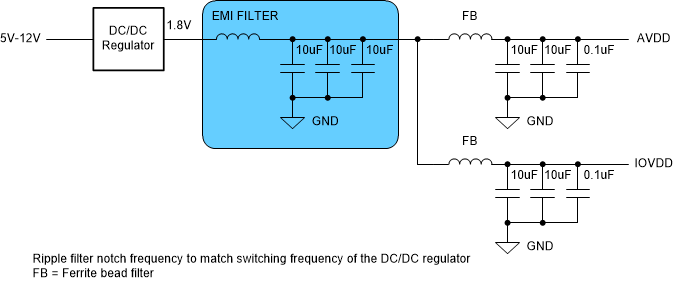JAJSLC0A March 2024 – December 2024 ADC3683-SP
PRODUCTION DATA
- 1
- 1 特長
- 2 アプリケーション
- 3 概要
- 4 Pin Configuration and Functions
-
5 Specifications
- 5.1 Absolute Maximum Ratings
- 5.2 ESD Ratings
- 5.3 Recommended Operating Conditions
- 5.4 Thermal Information
- 5.5 Electrical Characteristics - Power Consumption
- 5.6 Electrical Characteristics - DC Specifications
- 5.7 Electrical Characteristics - AC Specifications
- 5.8 Timing Requirements
- 5.9 Typical Characteristics
- 6 Parameter Measurement Information
- 7 Detailed Description
- 8 Application Information Disclaimer
- 9 Device and Documentation Support
- 10Revision History
- 11Mechanical, Packaging, and Orderable Information
パッケージ・オプション
デバイスごとのパッケージ図は、PDF版データシートをご参照ください。
メカニカル・データ(パッケージ|ピン)
- HBP|64
サーマルパッド・メカニカル・データ
発注情報
8.4 Power Supply Recommendations
The ADC3683-SP requires two different power supplies. The AVDD supply provides power for the internal analog circuits and to the ADC while the IOVDD supply powers the digital interface and the internal digital circuits. Power sequencing is not required.
A low noise power supply should supply the AVDD rail to achieve data sheet performance.
There are two recommended power-supply architectures:
- A high efficiency switching regulator followed by a low noise LDO to suppress the switching noise and improve voltage accuracy.
- Directly step down to the final ADC supply voltage using a high efficiency switching regulator. This approach provides the best efficiency; however, care must be taken to make sure the switching regulator noise doesn't degrade the ADC performance.
The TPS7H4002-SP is recommended as the first stage radiation hardened switching regulator. The switching regulator can be followed by either the TPS7A4501-SP or the TPS7H1111-SP which are both space hardened LDOs.
 Figure 8-2 Example LDO Based
Approach
Figure 8-2 Example LDO Based
Approach Figure 8-3 Example Switcher Only
Approach
Figure 8-3 Example Switcher Only
Approach